Cathode-ray tube monitors render sprites by precisely controlling electron guns to direct electron beams across the screen in a raster pattern. As the beam scans line by line, it modulates the beam’s intensity and color for each pixel, creating moving graphics that appear sharp and vibrant. Synchronization signals keep sprites stable and aligned, while high refresh rates reduce flicker. To discover how these intricate processes work together for smooth sprite display, keep exploring further.
Key Takeaways
- CRT monitors render sprites by precisely controlling electron beams to illuminate specific phosphor pixels, forming the sprite images.
- Electron guns direct focused beams at the screen, modulated in timing and intensity to create sprite shapes and colors.
- Raster scanning synchronizes the electron beam’s movement with refresh cycles, ensuring sprite stability and image clarity.
- Color blending and rapid beam modulation produce vivid, overlapping sprites while minimizing flicker and ghosting.
- High refresh rates and signal synchronization techniques prevent flicker, ghosting, and ensure sharp, stable sprite rendering.
The Fundamentals of CRT Display Technology
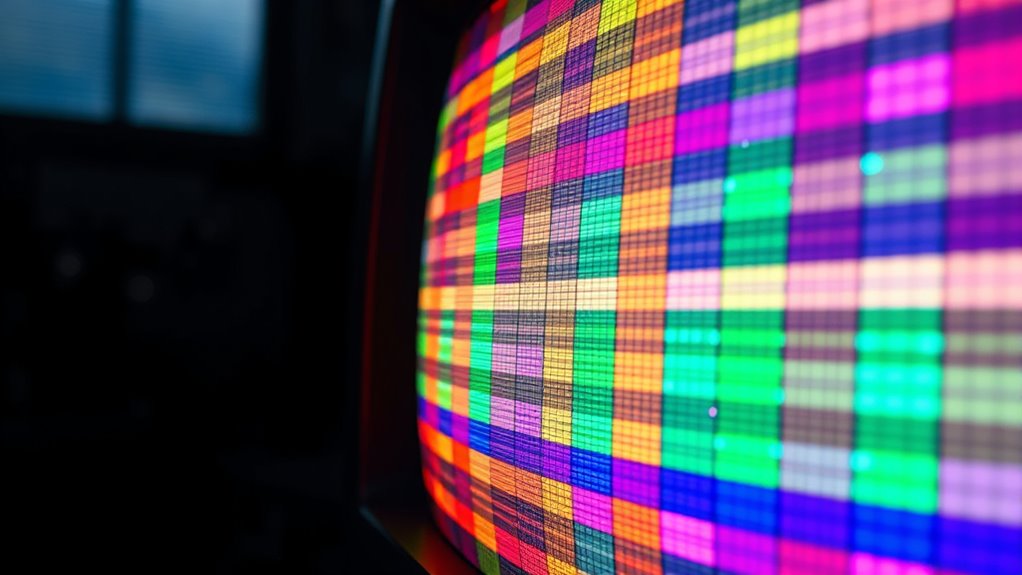
Cathode-ray tube (CRT) displays work by directing electron beams onto a phosphorescent screen to produce images. You control this process through electron acceleration, which speeds up electrons emitted from the cathode. These high-energy electrons travel through vacuum tubes and are guided by magnetic or electrostatic fields toward specific areas of the screen. Upon striking the phosphor coating, the electrons cause the phosphor to glow, creating visible pixels. However, phosphor decay limits how long the image remains visible, leading to flickering if refresh rates are too low. The electron beams must be precisely controlled to ensure sharp images and accurate sprite rendering. This combination of electron acceleration and phosphor response forms the core of CRT display technology, with innovative planter designs exemplifying how artistic elements can be incorporated into functional displays.
Electron Gun and Beam Steering Mechanisms
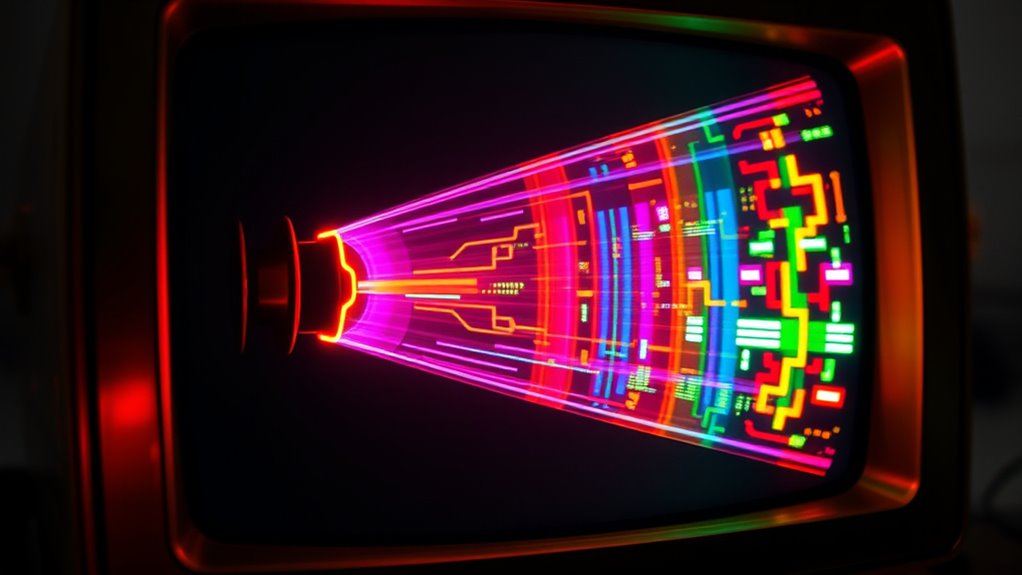
The electron gun and beam steering mechanisms are essential for directing electron streams accurately onto the screen. They focus and control the electron beam, ensuring precise sprite rendering. Your electron gun generates a focused stream of electrons, shaped by electron optics for accuracy. The beam steering system then directs this stream across the phosphor-coated screen, controlling horizontal and vertical movement. Key components include magnetic or electrostatic deflection coils that adjust the beam’s path. This precise control minimizes phosphor decay effects, maintaining image sharpness. To understand their function better:
Electron gun and beam steering precisely direct and shape the electron stream for sharp, accurate screen images.
- Electron gun design influences beam focus and intensity.
- Beam steering uses magnetic/electrostatic fields for accurate positioning.
- Electron optics shape the beam for sharp, stable sprites.
- Color accuracy impacts the overall image quality and visual fidelity in rendering sprites.
Raster Scanning Process and Frame Refresh

To display images on a CRT monitor, the electron beam scans the screen in a systematic pattern known as raster scanning. It moves horizontally line by line from top to bottom, renewing the entire frame repeatedly. As the beam hits the phosphor-coated screen, phosphor decay causes the glow to fade quickly, requiring continuous scanning to maintain brightness. A shadow mask ensures the electron beam hits only the correct phosphor dots for each color, keeping the image sharp. During each refresh cycle, the beam sweeps across the screen, updating pixel data and compensating for phosphor decay. This process happens rapidly, creating the perception of a stable, steady image. The frame refresh rate determines how smoothly the image appears, preventing flicker and ensuring consistent visual output. Additionally, understanding the legalities and zoning regulations can influence the placement and maintenance of CRT monitors in certain environments.
Modulating the Electron Beam for Color and Brightness
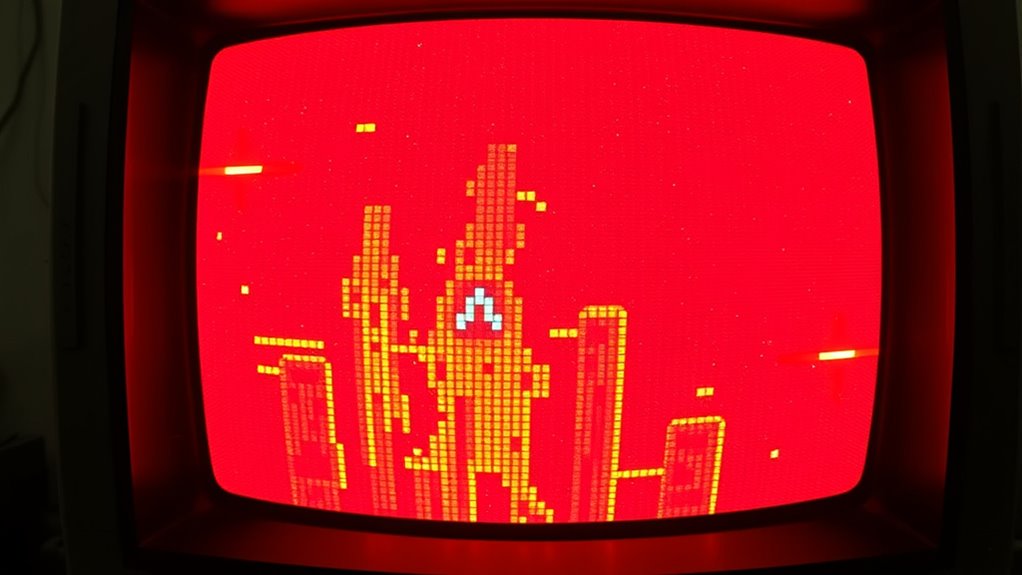
Modulating the electron beam is essential for producing vibrant colors and appropriate brightness levels on a CRT monitor. You control this by adjusting the electron acceleration, which influences the intensity and focus of the beam hitting the phosphor coating. The phosphor coating on the screen glows when struck, creating visible images. To achieve the desired colors and brightness, you manipulate three key aspects:
Modulating the electron beam adjusts color, brightness, and focus for vivid CRT images.
- Electron intensity – controlling the acceleration affects how brightly the phosphors glow.
- Color selection – directing electrons toward different phosphor coatings for red, green, or blue.
- Pulse modulation – rapidly turning the electron beam on and off to blend colors and adjust brightness levels.
This precise modulation guarantees sharp, colorful images that bring sprites to life on your CRT screen. Additionally, understanding the Power of Imagination can inspire innovative approaches to optimizing display technology.
Synchronization Signals and Their Role in Sprite Rendering
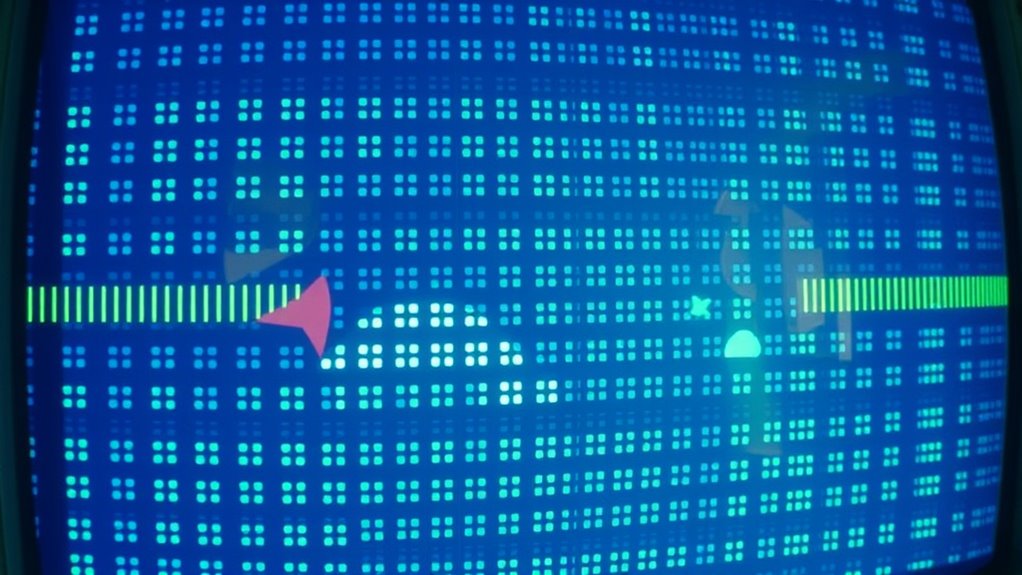
Synchronization signals like Horizontal and Vertical Sync tell the monitor when to start drawing each frame and line. Precise timing guarantees sprites appear stable and in the right position. Without accurate sync signals, your display can become jittery or misaligned. Proper understanding of monitor synchronization is essential for achieving smooth sprite rendering.
Horizontal and Vertical Sync
Have you ever wondered how monitors coordinate the precise timing needed to render sprites smoothly? Horizontal and vertical sync signals are essential for this process. They tell the electron beam when to start a new line or frame, ensuring images stay aligned. Without proper sync, you might see interlacing artifacts or flickering caused by mismatched timing. Here are three key points:
- Horizontal sync manages the electron beam’s return to the start of each line, preventing horizontal distortions.
- Vertical sync signals the start of a new frame, keeping sprites stable during motion.
- Sync signals help reduce issues like phosphor decay and flickering, maintaining image clarity.
- Understanding these signals clarifies how smooth sprite rendering depends on timing synchronization, preventing visual glitches and ensuring a crisp display.
Signal Timing Precision
Achieving smooth sprite rendering relies heavily on the precision of timing signals that coordinate the monitor’s electron beam. Any timing jitter or signal noise can cause the beam to misalign, resulting in flickering or tearing of sprites. Precise synchronization ensures that the electron beam scans accurately, displaying sprites exactly where they’re intended. When timing jitter occurs, it introduces small variations in signal timing, disrupting the tight synchronization needed for smooth motion. Signal noise can further distort the timing signals, making it harder for the monitor to maintain consistent sprite placement. To minimize these issues, monitors rely on stable sync signals, tight voltage controls, and filtering techniques. Maintaining high timing accuracy is vital for rendering sprites cleanly and avoiding visual artifacts during fast movements or complex scenes. Proper timing control is essential for preventing visual artifacts and ensuring seamless sprite motion.
Signal Processing Techniques for Moving Graphics
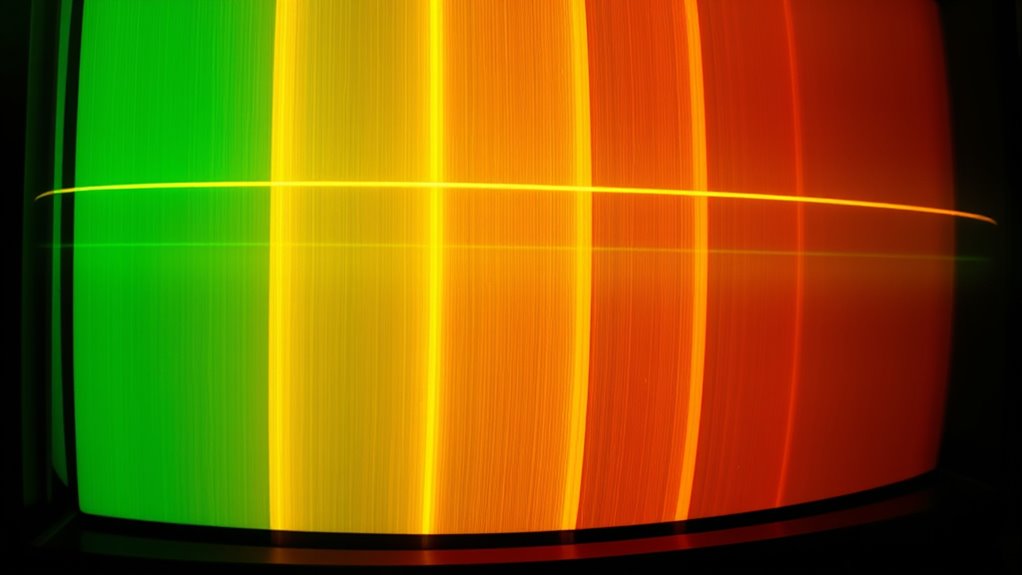
To accurately render moving graphics on a cathode-ray tube monitor, signal processing techniques must efficiently manage the rapid updates of image data. You need to contemplate how phosphor decay influences brightness, ensuring the image remains clear without ghosting. Adjusting electron velocity is vital to control the speed at which the beam hits the phosphor, preventing distortion during movement. You can enhance motion clarity by implementing techniques like:
- Frame Interpolation – smoothing sprite transitions for fluid motion.
- Electron Beam Modulation – regulating beam intensity and speed for accurate rendering.
- Signal Synchronization – aligning data updates with electron beam position to reduce flicker.
These methods optimize sprite movement, maintaining sharpness and minimizing artifacts in the dynamic display.
Managing Overlap and Flicker in Sprite Display
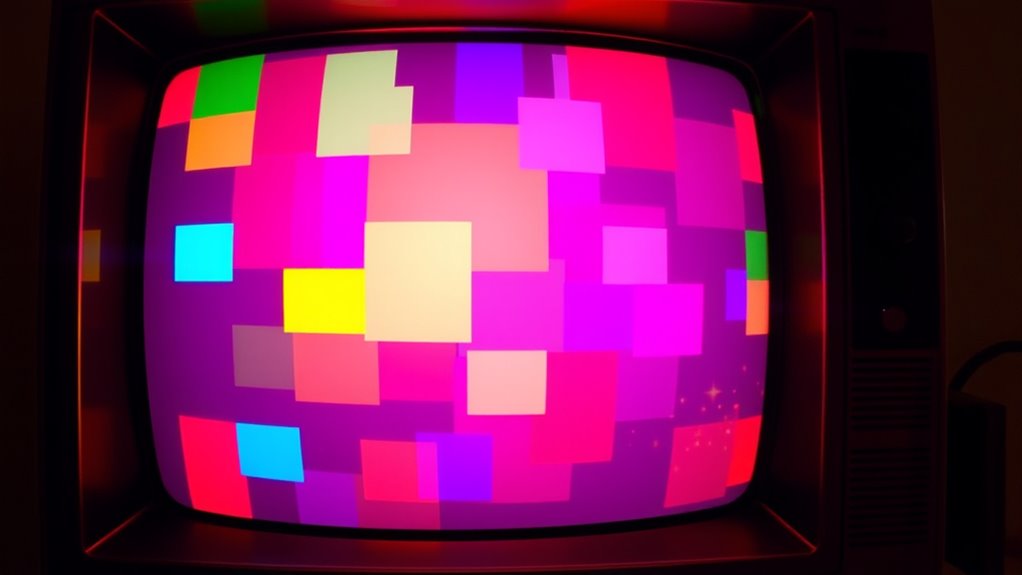
Managing overlap and flicker in sprite display requires precise control of the electron beam’s timing and intensity. To prevent flicker, CRT monitors use flicker suppression techniques, such as adjusting refresh rates or employing rapid electron beam scanning. Color blending plays a key role in managing overlapping sprites; by carefully coordinating the beam’s intensity and timing, you can blend colors smoothly, reducing visual artifacts. When sprites overlap, the monitor combines their signals to produce seamless transitions, minimizing flickering effects. Proper synchronization ensures that multiple sprites don’t cause flicker or ghosting, preserving image clarity. These techniques rely on accurate timing of the electron beam and the monitor’s phosphor response, guaranteeing overlapping sprites appear integrated and flicker-free. Additionally, understanding the display technology behind CRT monitors helps optimize sprite rendering for better visual stability on CRT screens. This careful management enhances the visual stability of moving graphics on CRT screens.
Limitations and Ingenious Solutions in CRT Sprite Rendering
CRT sprite rendering faces inherent limitations, such as restricted resolution, limited color palettes, and flicker artifacts caused by the refresh rate constraints. Pixel persistence and phosphor decay influence how sprites appear over time, often causing ghosting or blurring. To combat these issues, engineers devised clever solutions:
- Adjusting phosphor decay times—tailoring how long phosphors glow to reduce flicker and ghosting.
- Using high refresh rates—synchronizing sprite updates to minimize flicker artifacts.
- Implementing flicker reduction techniques—such as interlacing and dual-buffering, which improve sprite stability and clarity despite pixel persistence limitations.
These innovations helped optimize sprite display, overcoming the physical constraints of CRT technology and enhancing visual performance.
Frequently Asked Questions
How Do CRTS Handle Transparent or Semi-Transparent Sprites?
You might wonder how CRT monitors handle transparent or semi-transparent sprites. They use color blending and pixel masking techniques to achieve this effect. When rendering, the monitor blends sprite colors with the background pixels, creating semi-transparency. Pixel masking helps to define transparent areas, allowing the background to show through. This process results in smooth transparency effects, giving sprites a more realistic appearance on CRT screens.
What Role Does Phosphor Coating Play in Sprite Visibility?
Think of phosphor coating like a glow-in-the-dark sticker on a wall. It plays a crucial role in sprite visibility by emitting a phosphor glow when struck by electron beams, making sprites appear bright and clear. The coating’s durability ensures consistent glow over time, maintaining sprite clarity. Without a good phosphor coating, sprites would fade quickly or appear dim, reducing visual quality and gameplay experience.
Can CRTS Display High-Resolution Sprites Without Flickering?
You might wonder if CRTs can display high-resolution sprites without flickering. The answer depends on the electron beam’s precision and phosphor persistence. CRTs use a focused electron beam to excite phosphor coating, creating images. If phosphor persistence is high, flickering reduces because the image stays visible longer. However, at very high resolutions, rapid scanning can cause flickering unless the phosphor’s persistence is optimized for stable, flicker-free display.
How Are Sprite Animations Synchronized With CRT Refresh Rates?
You want smooth sprite animations on CRTs, so you focus on refresh rate synchronization. By aligning your sprite updates with the monitor’s refresh cycle, you prevent flickering and achieve fluid motion. This process involves synchronizing the timing of sprite rendering with the CRT’s scanlines, ensuring each frame updates seamlessly. When you master refresh rate synchronization, you reduce sprite flickering, making your animations look crisp, consistent, and visually appealing.
What Are the Modern Alternatives to CRT Sprite Rendering?
Modern alternatives to CRT sprite rendering rely on digital signal processing to create smooth, high-quality visuals. You actively utilize anti-aliasing techniques, like MSAA or FXAA, to minimize jagged edges and enhance sprite clarity. These methods allow you to render sprites seamlessly on LCD or OLED screens, providing sharper images and better color accuracy. You no longer depend on the refresh rate synchronization used in CRTs, making your graphics more flexible and visually appealing.
Conclusion
Understanding how CRT monitors render sprites reveals the remarkable engineering behind old-school displays. Did you know that CRTs could refresh images up to 70 times per second, ensuring smooth motion? This rapid refresh rate helped reduce flicker and manage overlapping sprites effectively. By mastering beam modulation and synchronization, CRTs created vibrant, dynamic graphics despite their limitations. Appreciating these techniques highlights the ingenuity that brought sprites to life on classic monitors, showcasing a fascinating blend of physics and electronics.








